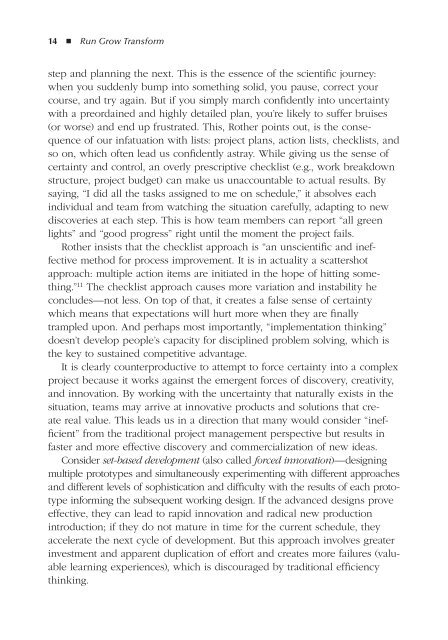Run-Grow-Transform-Chapter-One-distribute-freely
Run-Grow-Transform-Chapter-One-distribute-freely
Run-Grow-Transform-Chapter-One-distribute-freely
Create successful ePaper yourself
Turn your PDF publications into a flip-book with our unique Google optimized e-Paper software.
14 ◾ <strong>Run</strong> <strong>Grow</strong> <strong>Transform</strong><br />
step and planning the next. This is the essence of the scientific journey:<br />
when you suddenly bump into something solid, you pause, correct your<br />
course, and try again. But if you simply march confidently into uncertainty<br />
with a preordained and highly detailed plan, you’re likely to suffer bruises<br />
(or worse) and end up frustrated. This, Rother points out, is the consequence<br />
of our infatuation with lists: project plans, action lists, checklists, and<br />
so on, which often lead us confidently astray. While giving us the sense of<br />
certainty and control, an overly prescriptive checklist (e.g., work breakdown<br />
structure, project budget) can make us unaccountable to actual results. By<br />
saying, “I did all the tasks assigned to me on schedule,” it absolves each<br />
individual and team from watching the situation carefully, adapting to new<br />
discoveries at each step. This is how team members can report “all green<br />
lights” and “good progress” right until the moment the project fails.<br />
Rother insists that the checklist approach is “an unscientific and ineffective<br />
method for process improvement. It is in actuality a scattershot<br />
approach: multiple action items are initiated in the hope of hitting something.”<br />
11 The checklist approach causes more variation and instability he<br />
concludes—not less. On top of that, it creates a false sense of certainty<br />
which means that expectations will hurt more when they are finally<br />
trampled upon. And perhaps most importantly, “implementation thinking”<br />
doesn’t develop people’s capacity for disciplined problem solving, which is<br />
the key to sustained competitive advantage.<br />
It is clearly counterproductive to attempt to force certainty into a complex<br />
project because it works against the emergent forces of discovery, creativity,<br />
and innovation. By working with the uncertainty that naturally exists in the<br />
situation, teams may arrive at innovative products and solutions that create<br />
real value. This leads us in a direction that many would consider “inefficient”<br />
from the traditional project management perspective but results in<br />
faster and more effective discovery and commercialization of new ideas.<br />
Consider set-based development (also called forced innovation)—designing<br />
multiple prototypes and simultaneously experimenting with different approaches<br />
and different levels of sophistication and difficulty with the results of each prototype<br />
informing the subsequent working design. If the advanced designs prove<br />
effective, they can lead to rapid innovation and radical new production<br />
introduction; if they do not mature in time for the current schedule, they<br />
accelerate the next cycle of development. But this approach involves greater<br />
investment and apparent duplication of effort and creates more failures (valuable<br />
learning experiences), which is discouraged by traditional efficiency<br />
thinking.<br />
TAF-K14527-12-0302-C001.indd 14<br />
13/08/12 8:25 PM


